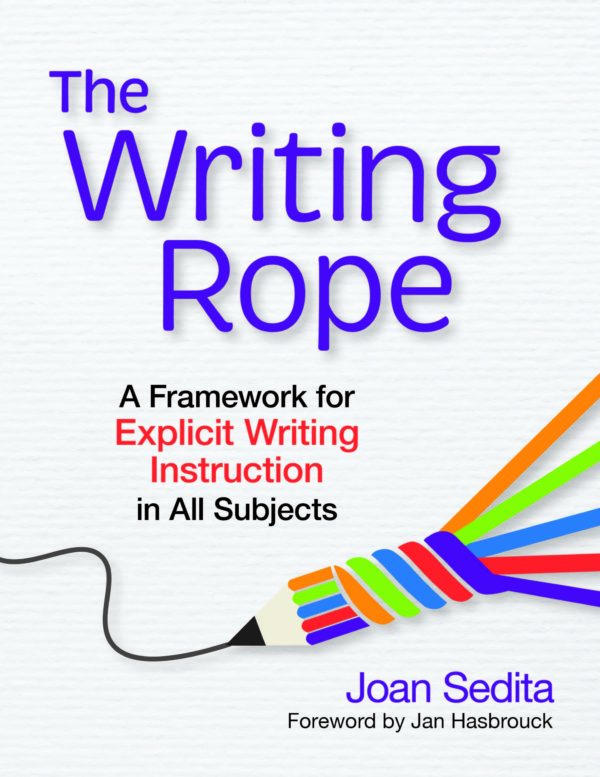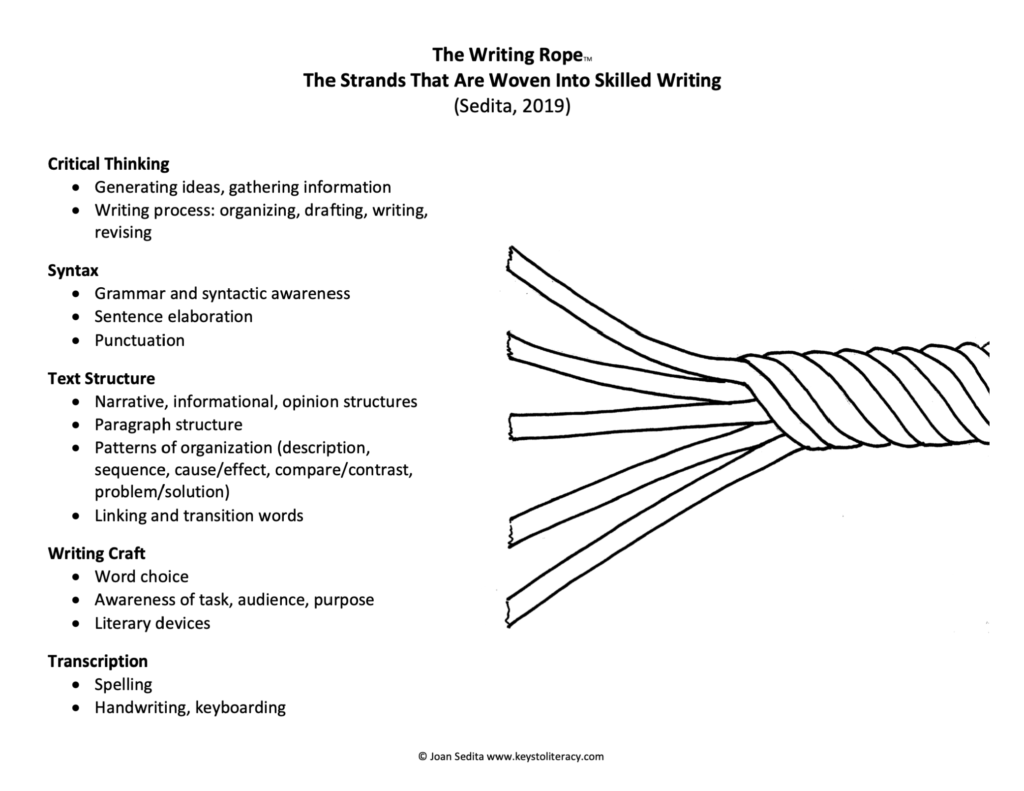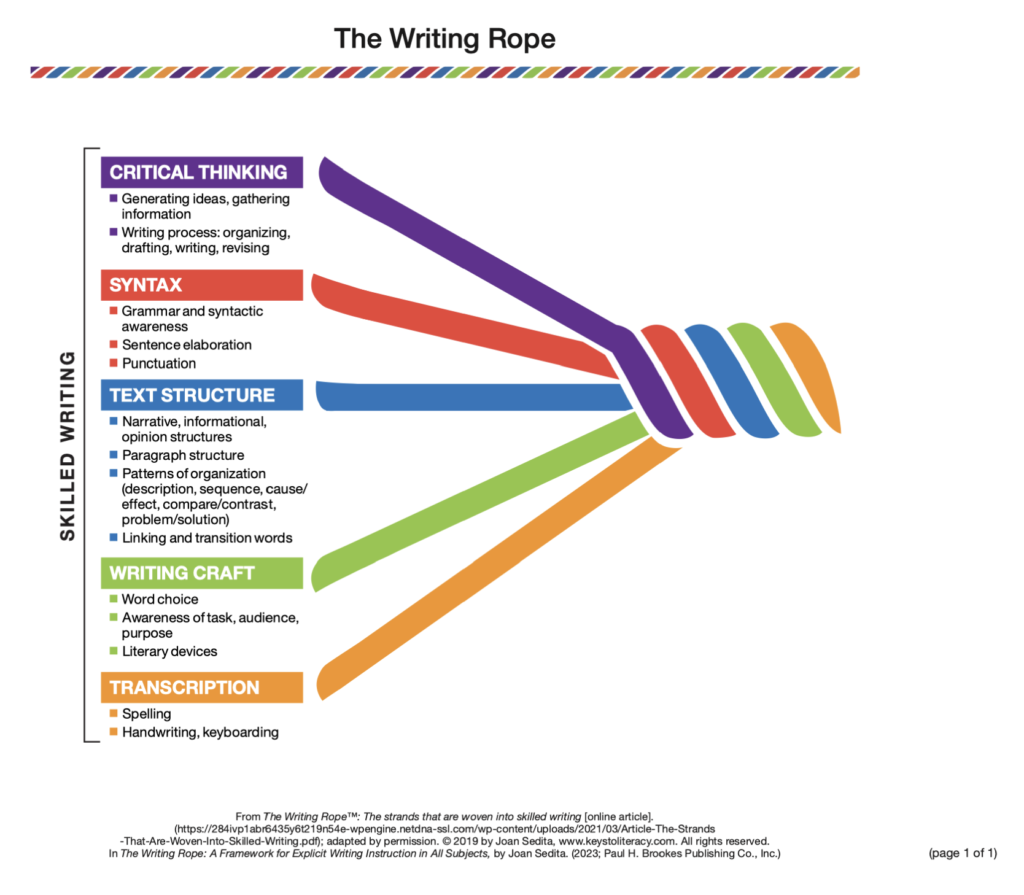New Book: The Writing Rope

I am pleased to announce that Brookes Publishing in August published my new book titled The Writing Rope: A Framework for Explicit Writing Instruction in All Subjects. I am also delighted that my friend and colleague, Jan Hasbrouck, wrote the foreword. The book can be ordered at the Brookes website (and click here for a free book study guide). I wrote about The Writing Rope framework in a 2019 article, and again in a Literacy Lines January 2020 blog post. Later, the International Dyslexia Association included it in their collection of infographics.
Why did I create The Writing Rope framework?
I had been thinking about the need for a model that could identify the components that make up skilled writing for a while. The literature and discourse related to literacy instruction tends to focus on reading, even though writing is just as important for student literacy achievement. Much has been written about the multiplicity of skills involved in reading, beginning with the “five components” necessary for skilled, fluent reading that became popular after the 2000 report of the National Reading Panel (i.e., phonemic awareness, phonics, fluency, vocabulary, comprehension). On the other hand, when attention is paid to writing instruction, teachers are not sure what to include. Many educators who are knowledgeable about effective reading instruction are not able to identify the components of skilled writing or essential elements of a curriculum for teaching writing. I developed The Writing Rope to help educators readily identify these components.
Over the past ten years, with the help of the team at Keys to Literacy, I published the Keys to Early Writing and Keys to Content Writing courses that have been used to train teachers across the U.S. The professional development experiences with teachers that resulted, combined with the research on effective writing instruction, form the basis for The Writing Rope. I organized the numerous skills, strategies, and techniques that students need to integrate for skilled writing into five components. To visually represent the components, I first considered the metaphor of a wagon wheel to represent how the components work together, like spokes in a wheel. But I kept thinking about the powerful image of the rope strands in Hollis Scarborough’s Reading Rope, and decided to develop my framework with a nod towards that model. One of my hobbies is drawing and water color painting, and one night I sat down and sketched out a drawing of a rope and added wording for the five strands (shown below). For the new book, the graphic designers at Brookes Publishing did a great job of adding color to the rope (also shown below).


How can The Writing Rope be used?
As noted above, my original intention was to develop a framework that could identify the major components that make up skilled writing. It can be used by administrators and curriculum directors to help determine if the writing curriculum being used covers all essential writing skills and strategies. It can also be used to review writing programs that are being considered – which components are included, and what’s missing. For English language arts teachers, The Writing Rope can serve as a master plan to help teachers make sure they are providing instruction for all the strands in the rope. For content teachers of all subjects, the first three strands of the rope (Critical Thinking, Syntax, Text Structure) include instructional suggestions that can be integrated in content instruction. For those who read The Writing Rope book, I included significant references to the research related to writing instruction so teachers can see how the suggested instructional practices are evidence based. I also included “Connect to Your Classroom” activities to help readers apply what they learn to their teaching.
What grades are addressed?
While the book was written with educators of students in grades 4-8 in mind, teachers will find instructional suggestions that can be used across all grades. For example, the suggestions for developing syntactic awareness and improved sentence-writing (such as sentence-combining) are helpful for primary grade students, as well as older students who do not have strong sentence writing ability. The instructional suggestions under the critical thinking strand for the stages of the writing process and strategies for writing about text sources (such as two-column note taking) can be introduced with second and third graders, and also used by high school students who are writing research papers.
How is The Writing Rope book organized?
The book chapters are organized into three sections, listed below:
Part 1: Laying the Foundations for Teachers & Students
- 1 Introduction to The Writing Rope
- 2 What do we know about effective writing instruction?
- 3 Transcription skills
- 4 Writing craft
Part 2: Skills and Strategies – Learning to Write
- 5 Critical Thinking: Stages of the writing process
- 6 Syntax and sentence skills
- 7 Text Structure: Paragraph Skills
- 8 Text Structure: The three types of writing
Part 3: Application – Writing to Learn
- 9 Critical Thinking: Summary writing
- 10 Critical Thinking: Writing from text sources
- 11 Putting it all together
Related Professional Development
If you are interested in participating in live or online professional development that includes instructional practices found in The Writing Rope book, contact Keys to Literacy for information about Keys to Early Writing (for grades K-2) and Keys to Content Writing (for grades 3-12).

 Joan Sedita is the founder of Keys to Literacy and author of the Keys to Literacy professional development programs. She is an experienced educator, nationally recognized speaker and teacher trainer. She has worked for over 35 years in the literacy education field and has presented to thousands of teachers and related professionals at schools, colleges, clinics, and professional conferences.
Joan Sedita is the founder of Keys to Literacy and author of the Keys to Literacy professional development programs. She is an experienced educator, nationally recognized speaker and teacher trainer. She has worked for over 35 years in the literacy education field and has presented to thousands of teachers and related professionals at schools, colleges, clinics, and professional conferences.
This seems to be a great match for those looking for just the right way to teach writing. It is a skill that falls by the wayside while districts go full steam on reading. Writing goes hand in hand with reading, but is left to be a different skill.
My district utilizes Amplify for a reading/ELA curriculum. How can we incorporate The Writing Rope into that? How can we model this while using Amplify?
Can we talk about getting you to come here (Manchester, NH) to present on this?
Thank you.
I am looking forward to sharing the writing ropes with my Kindergarten scholar’s.
Hello from New Zealand.
Is it OK to use your ‘free’ resources within our school?
What about your great “Reading Rope graphic- can I use it in our school curriculum documentation, please?
We have ordered your book!
Lyndal
The Keys to Literacy free resources can be used in schools as long as a citation is used noting that the source and owner of the copyright is Keys to Literacy. Given that these materials are under copyright protection, they cannot be copied or distributed beyond the use in schools with students.